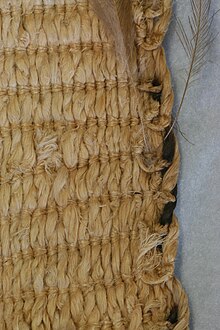
Muka is prepared fibre of New Zealand flax (Māori: harakeke).[1] Prepared primarily by scraping, pounding and washing, it is a key material in Māori traditional textiles where it is usually used in tāniko or twined weaving. Some varieties produce different grades or quality of muka that result in characteristics such as strength, whiteness or shine.[2]
In pre-European times, muka was widely used by the Māori and was the primary fibre used for weaving clothing. Patu muka or pounding stones were a distinct tool type.[3]
In the early colonial period, muka was a trade staple, often being traded for muskets with devastating effects.[4] Well into the European era it was used for paper, clothing and sacking, with large commercial workings in Foxton and elsewhere.[5]
Since the Māori renaissance the resurgence in traditional Māori weaving has seen up-swing in the use of muka, especially for art and high-end craft items. Usually woven muka is distinguished from woven (unprepared) flax which is only suitable for coarse work such as bags (kete) and panels.
- ^ "Māori Dictionary". maoridictionary.co.nz. 2011. Archived from the original on 25 April 2012. Retrieved 10 October 2011.
(noun) prepared flax fibre. He harakeke iraira, he mumura te kākāriki o ngā whā, he kōwhai ngā tāekaeka, he karaka ngā tapa me te tuaka, he mā, he mōhinuhinu te muka o tēnei harakeke (PK 2008:603). A variegated flax, with bright green leaves, yellow stripes, orange edges and midrib, while the fiber of this flax is white and shiny.
- ^ Chitham, Karl (2019). Crafting Aotearoa : a cultural history of making in New Zealand and the wider Moana Oceania. Kolokesa Uafā Māhina-Tuai, Damian Skinner, Rigel Sorzano. Wellington, New Zealand: Te Papa Press. p. 15. ISBN 978-0-9941362-7-5. OCLC 1118996645.
- ^ "Patu muka - Collections Online - Museum of New Zealand Te Papa Tongarewa". collections.tepapa.govt.nz. 2011. Retrieved 10 October 2011.
- ^ "The early flax trade - Flax and flax working — Te Ara". teara.govt.nz. 2011. Retrieved 10 October 2011.
The Māori producers were not paid in cash but in goods – usually muskets. The trade therefore had a lasting impact on Māori society. With firearms, conflicts between tribes turned into full-scale wars. Tribes competed for control of the flax trade and thus the supply of muskets.
- ^ "Last flax cut, Foxton - Manawatū and Horowhenua places — Te Ara". teara.govt.nz. 2011. Retrieved 10 October 2011.